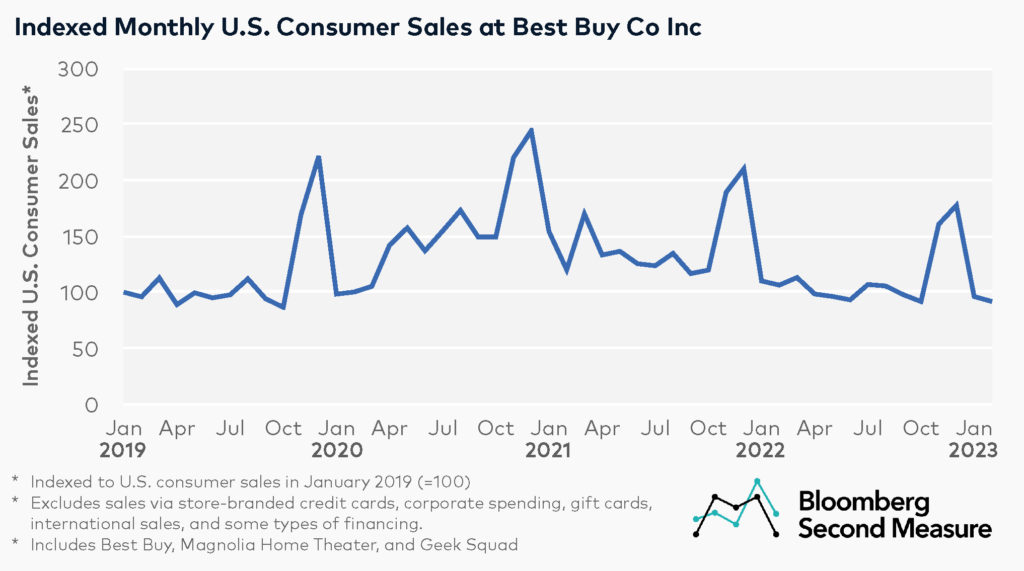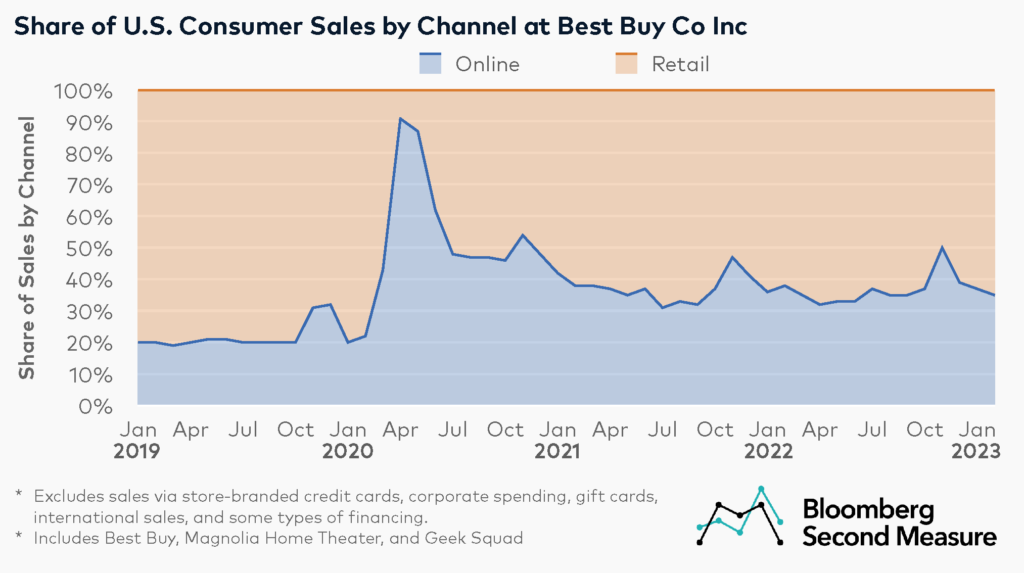In its recent fourth quarter earnings call, Best Buy Co Inc (NYSE: BBY) projected another year of lower consumer spending on electronics. The electronics retailer saw strong consumer sales in the early months of the COVID-19 pandemic, as work-from-home policies drove spending on home office equipment. More recently, however, Best Buy has experienced challenges related to high inflation, supply chain issues, and waning demand. Bloomberg Second Measure’s transaction data shows that while Best Buy’s consumer sales in January and February of 2023 were lower than the same months in the previous four years, the percentage of its consumer sales coming from the online channel and average sales per customer have remained elevated compared to pre-pandemic levels.
U.S. consumer sales at Best Buy Co Inc (NYSE: BBY) in January and February of 2023 were lower than previous years
Consumer transaction data reveals that in January and February of 2023, Best Buy’s consumer sales for those two months combined decreased 13 percent year-over-year and 31 percent compared to the same months in 2021. Best Buy’s consumer sales in January and February of 2023 were also 5 percent lower than those months in 2020 and 4 percent lower than in 2019. It is worth noting that Bloomberg Second Measure data excludes sales via gift card, corporate spending, and some types of financing. It also excludes international sales.

Looking at annual patterns, Best Buy’s highest sales volume takes place in November and December of each year. Combined U.S. consumer sales in November and December of 2022 were also lower than the same time period in the prior three years (15 percent lower compared to those months in 2021, 27 percent lower compared to 2020, and 13 percent lower than in 2019). Best Buy is well-known for its Black Friday sales events, though the company has been closed on Thanksgiving Day since 2020.
As part of its efforts to retain customers and increase sales amid the economic uncertainty of the pandemic and high inflation, Best Buy rolled out its Total Tech membership program nationwide in 2021. For an annual cost of about $200, Total Tech offers benefits such as product protection, early access to tech deals (including high-demand products during the holiday season), and delivery and installation perks.
Best Buy has sustained its COVID-era shift to online sales
Like many retailers, Best Buy experienced a shift to online sales at the onset of the COVID-19 pandemic. At the height of the pandemic in April and May of 2020, the monthly share of online sales at Best Buy rose to 91 percent and 87 percent, respectively. Consumer spending data reveals that through early 2023, the share of online sales as a percentage of total consumer sales at Best Buy has remained higher than pre-pandemic levels.

In February 2023, 35 percent of Best Buy’s U.S. consumer sales came from the online channel. The share of online sales was 38 percent in February 2022 and February 2021, 22 percent in February 2020, and 20 percent in February 2019. Best Buy also sees an uptick in the share of online sales each November, likely in part due to Black Friday and Cyber Monday deals.
The company has experimented with various retail strategies over the past few years. For example, Best Buy piloted a small-format, “digital-first” store in 2022 and has also been opening more outlet stores.
Best Buy’s average sales per customer has also remained elevated compared to pre-pandemic levels
Diving deeper into how consumer spending on electronics has evolved during the pandemic, Bloomberg Second Measure data further reveals that Best Buy’s average monthly sales per customer has remained elevated compared to pre-COVID levels. However, for most months since April 2021, the average monthly sales per customer has declined year-over-year, even though the inflation rate has increased.

The average sales per customer at Best Buy in February 2023 was $259, a 4 percent decrease compared to the same month in the previous year. However, it was 31 percent higher than in February 2019 and 23 percent higher than in February 2020. Best Buy’s average sales per customer is also elevated in November compared to the other months of the year, with Black Friday and Cyber Monday likely playing a role. In November 2022, the average sales per customer was $305, a 21 percent increase from the prior month.
One of the macroeconomic challenges faced by electronics retailers like Best Buy in 2021 and 2022 was chip shortages, which contributed to electronics inflation. Another factor that could affect average sales per customer in the long run is Best Buy’s foray into resale. Best Buy’s outlet stores sell refurbished electronics—at a lower price point than new items—to price-conscious consumers amid high inflation. The outlet stores are also equipped to handle electronics repairs, in addition to selling products.
Bloomberg Second Measure launched a new and exclusive transaction dataset in July 2022. Our data continues to be broadly representative of U.S. consumers. As a result of this panel change, however, we recommend using only the latest post in assessing metrics, and do not support referring to historical blog posts to infer period-over-period comparisons.
